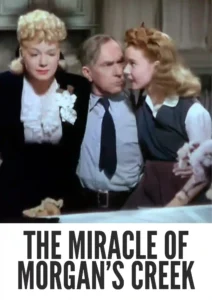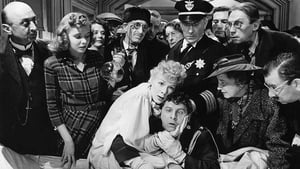Video Sources 0 Views

Synopsis

Step back in time to the whirlwind of wartime America with The Miracle of Morgan’s Creek, a riotous screwball comedy from 1943, now brilliantly colorized for a fresh and vibrant viewing experience. Directed by Preston Sturges, this film delivers a cascade of laughs, misunderstandings, and small-town absurdity. Perfect for fans of classic comedies and those seeking a lighthearted escape, this HD download brings a cherished piece of cinematic history to your screen. Often considered a satire, the film remains a unique and daring piece of comedic cinema. Some alternative titles the film has been released under include Hail the Conquering Heroine.
The Miracle of Morgan’s Creek centers on the dizzying escapades of Trudy Kockenlocker (Betty Hutton), a seemingly innocent small-town girl with an insatiable appetite for excitement. Eager to do her part for the war effort, Trudy attends a raucous farewell party for departing soldiers. Overwhelmed by the patriotic fervor and perhaps a bit too much celebratory cheer, Trudy wakes up the next morning with a monumental problem: she can’t remember who she married the night before, and she’s now pregnant.Enter Norval Jones (Eddie Bracken), Trudy’s eternally devoted but hopelessly inept admirer. Norval, a 4-F reject with a heart of gold, agrees to help Trudy navigate this increasingly chaotic situation. What follows is a series of increasingly ludicrous schemes, misunderstandings, and close calls as Norval attempts to rectify Trudy’s “little problem” without incurring the wrath of her strict father, Constable Kockenlocker (William Demarest), or scandalizing the entire town. The film culminates in a series of increasingly improbable events, solidifying its status as a screwball masterpiece.
The film boasts a stellar cast of comedic talents who bring this uproarious story to life:
- Betty Hutton as Trudy Kockenlocker
- Eddie Bracken as Norval Jones
- William Demarest as Constable Kockenlocker
- Diana Lynn as Emmy Kockenlocker
- Porter Hall as Justice of the Peace
The Miracle of Morgan’s Creek firmly resides in the genre of screwball comedy, with elements of satire and social commentary woven throughout. Its fast-paced dialogue, farcical situations, and larger-than-life characters make it a quintessential example of the genre.
Released in 1944, during the height of World War II, The Miracle of Morgan’s Creek offered audiences a much-needed dose of laughter amidst the anxieties and uncertainties of wartime. The film’s audacious humor and subversive themes challenged the prevailing social norms of the time, pushing the boundaries of what was considered acceptable in Hollywood cinema. Despite initial concerns from censors, the film became a box-office smash, solidifying Preston Sturges’ reputation as a comedic visionary.
This colorized version of The Miracle of Morgan’s Creek has been painstakingly restored using cutting-edge digital technology, enhancing the visual experience while preserving the film’s original comedic charm. The colorization process involved a meticulous analysis of the original black and white footage, with careful attention paid to recreating the vibrant colors of wartime America. Advanced algorithms were used to ensure accurate color palette selection and seamless image enhancement. The end result is a visually stunning and engaging viewing experience that brings new life to this classic comedy.
- : Preston Sturges
- : Preston Sturges
- : John F. Seitz
- : Elsa Gidlow
- : Paramount Pictures
- : Paramount Pictures
- : 99 minutes
- : MP4
- : HD (1080p)
- : Compatible with most devices, including smartphones, tablets, computers, and smart TVs.
The Miracle of Morgan’s Creek is widely regarded as one of Preston Sturges’ finest achievements and a landmark in American comedy. Its sharp wit, irreverent humor, and daring social commentary have earned it critical acclaim and a lasting legacy. The film continues to resonate with audiences today, offering a timeless and hilarious reflection on American society.
- : What is The Miracle of Morgan’s Creek about?
- A: The Miracle of Morgan’s Creek is a screwball comedy about a small-town girl who wakes up pregnant with no memory of who the father is.
- : Is The Miracle of Morgan’s Creek (1944) a well-known comedy?
- A: Yes, The Miracle of Morgan’s Creek is considered a classic of the screwball comedy genre and one of Preston Sturges’ most celebrated films.
- : Is this version of The Miracle of Morgan’s Creek colorized?
- A: Yes, this version has been professionally colorized to enhance the viewing experience.
- : What makes The Miracle of Morgan’s Creek so funny?
- A: The Miracle of Morgan’s Creek is known for its fast-paced dialogue, farcical situations, and sharp satire of American society.
- : What is the download format?
- A: The download format is MP4, which is compatible with most devices.
- : What resolution is the download?
- A: The resolution is HD (1080p), providing a high-quality viewing experience.
Watch The Miracle of Morgan’s Creek Today!












